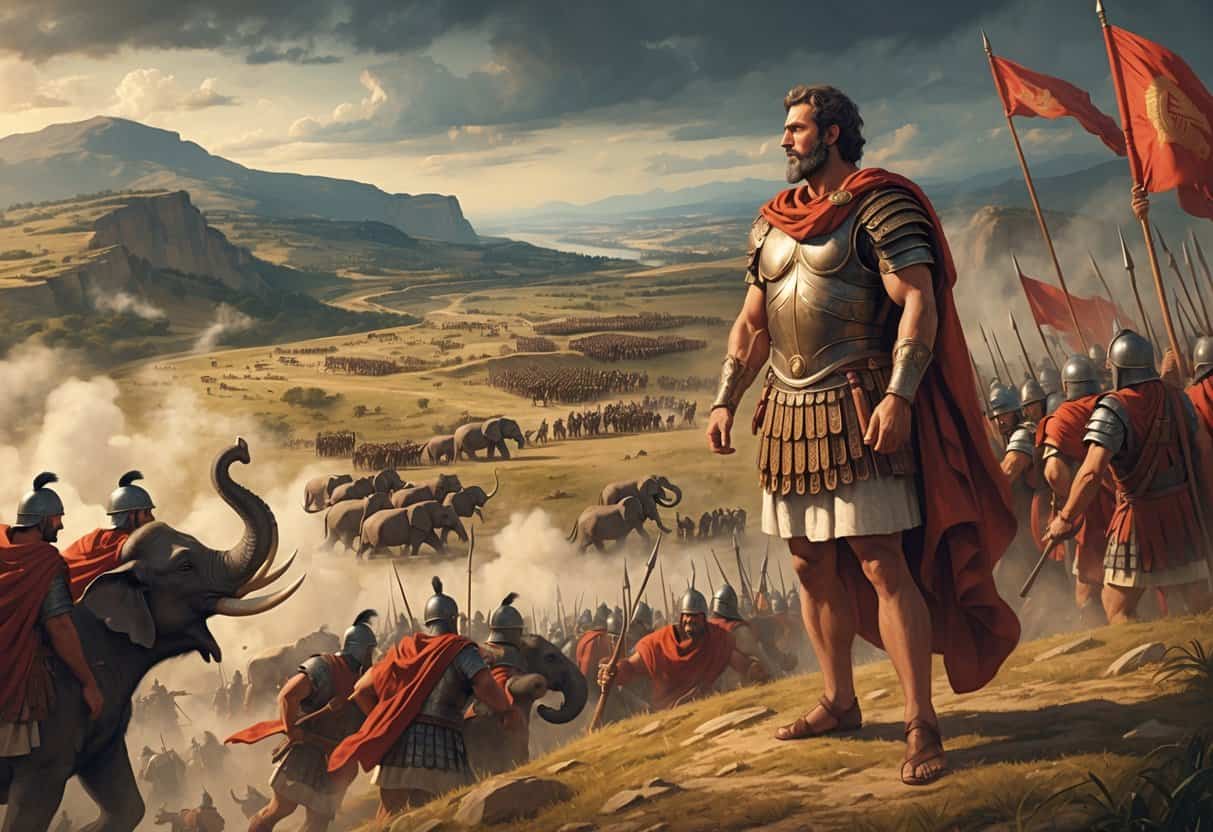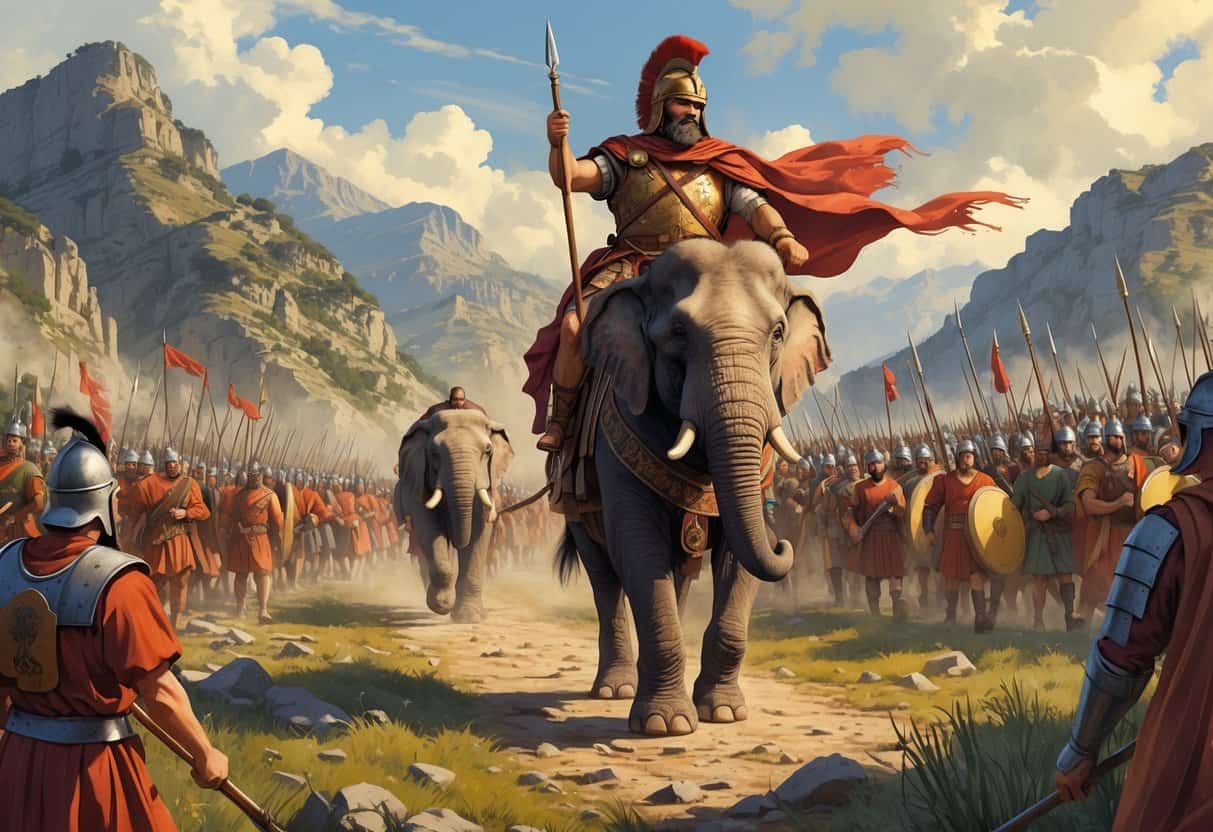Hannibal Barca stands out as one of history’s most daring military leaders, especially for his bold moves during the Second Punic War.
His audacious crossing of the Alps and legendary victories like Cannae left Rome reeling and changed how the Romans fought.

Hannibal’s knack for surprise and speed let him take on much larger Roman forces.
He didn’t just fight—he outmaneuvered, using clever tricks that kept Rome guessing.
It’s no wonder his campaigns are still picked apart in military academies.
The impact of these battles went way beyond the battlefield, shaping the destinies of both Rome and Carthage.
Looking at Hannibal’s wins, you really get how one person’s tactics can shake up an empire.
Key Takeaways
- Hannibal’s tactics gave him the edge in his early clashes with Rome.
- His moves forced Rome to rethink how it fought wars.
- The campaign left a deep imprint on both Carthage and Rome’s history.
Hannibal Barca: Strategic Brilliance and Background

Let’s dive into Hannibal’s roots, his family’s influence, and how he got so good at outsmarting Rome.
His rise was fueled by strong family ties and hard-won lessons from Carthage’s military world.
Rise of Hannibal and Early Influences
Hannibal was born in Carthage around 247 BC, right into a military powerhouse of a family.
His dad, Hamilcar Barca, had already tangled with Rome in the First Punic War.
From the start, Hannibal was raised to distrust Rome and to value strength on the battlefield.
He grew up in Iberia, where Carthage kept its grip on the region and trained up-and-coming commanders.
Early on, he fought under his father’s watchful eye—nothing like some real action to sharpen your skills.
His brothers, Hasdrubal and Mago, were always in the mix too, leading armies and backing Carthage’s ambitions.
Those family bonds gave Hannibal the confidence and know-how he’d need to face Rome.
Carthaginian Military Commander and Family Legacy
As a commander, Hannibal carried the Barca name with a mix of pride and pressure.
The Barcas had a reputation for loyalty and battlefield smarts—no small shoes to fill.
Carthage itself was a Phoenician powerhouse, obsessed with trade and flexing military muscle across the western Mediterranean.
After losing the First Punic War, Carthage leaned hard on leaders like Hannibal to take back lost ground, especially in Iberia.
Hannibal was good at uniting soldiers from all over, building trust and respect among troops from different backgrounds.
His ability to inspire made him a legend, even among his enemies.
Preparation for War: Tactics and Strategies
Hannibal didn’t just stumble into his victories—he planned every move, especially as the Second Punic War heated up.
He loved surprising the Romans with the unexpected.
Who would’ve guessed he’d drag war elephants across the Alps?
That move alone caught Rome totally off guard.
Ambushes, rapid marches, and picking his battles carefully—these were all part of his playbook.
He forced Rome to fight on his terms, using his army’s strengths and the enemy’s weak spots.
The Greatest Victories Against Rome
Let’s get into the battles that made Hannibal a legend.
He took risks, marched through brutal terrain, and outfoxed the Romans again and again.
Crossing the Alps and the March Through Southern Gaul
The campaign kicked off with Hannibal’s wild decision to cross the Alps.
It was a nightmare—cold, starvation, attacks from mountain tribes.
And yet, those war elephants? They terrified enemies and kept his army’s spirits up, even when things looked grim.
Once through the mountains, Hannibal swept through Southern Gaul.
He picked up allies and kept clear of big fights, giving his army time to regroup before hitting Italy.
His knack for reading maps and making friends on the fly really paid off.
Battle of Trebia: Tactics and Aftermath
At the Trebia River, Hannibal faced off with the Romans early in the campaign.
He set a trap, hiding troops in the woods and luring the Romans into a freezing river.
Once the Romans were tired and cold, Hannibal’s forces attacked from every direction.
The Romans never stood a chance—caught off guard and exhausted, they suffered heavy losses.
Tactical trickery mixed with grit gave Hannibal the win.
Lake Trasimene: Ambush and Decisive Victory
Lake Trasimene was all about the ambush.
Hannibal used fog and the hilly terrain to hide his troops along a narrow path.
When the Romans marched through, he struck from all sides.
It turned into one of the biggest ambush victories ever.
The Romans were trapped, and the losses were staggering.
Hannibal’s legend only grew from there.
Battle of Cannae: Hannibal’s Legendary Triumph
At Cannae, Hannibal faced a Roman army that outnumbered him.
But he pulled off a double-envelopment—his troops surrounded the Romans completely.
Rome sent its best, but Hannibal’s mix of infantry and cavalry was just too sharp.
Thousands of Romans died in a single day.
This battle forced Rome to rethink everything and became a classic in military history.
Impact and Legacy of Hannibal’s Campaigns
Hannibal’s victories forced Rome to change tactics and rethink alliances.
His battles shifted power in North Africa and the Mediterranean.
His influence lingers, even in today’s military playbooks.
Rome’s Response and the Fabian Strategy
After Cannae, Rome stopped playing Hannibal’s game.
Quintus Fabius Maximus led the way, avoiding big battles and wearing Hannibal down with hit-and-run tactics.
This “Fabian strategy” was all about patience—no more risky showdowns.
Roman legions stuck close to supply lines, making sure Hannibal couldn’t catch them off guard again.
It was a slow grind, but it kept Rome in the fight.
Effects on Carthage and the Mediterranean
Hannibal’s long campaigns drained Carthage’s resources.
In the end, Carthage had to pay up and lost its grip on the Mediterranean.
Rome’s allies mostly stayed loyal, which helped them bounce back.
Carthage lost its edge in trade and politics, and after Hannibal’s exile, it faded as a rival.
Long-term Influence on Military Strategy
Hannibal’s love for surprise attacks and using tough terrain changed how generals thought about war.
That Alpine crossing? Still jaw-dropping.
His tactics—flexibility, reading the enemy, mixing up his forces—are still studied by military leaders.
Even Rome’s Scipio Africanus borrowed a few moves from Hannibal when he finally beat Carthage.
His campaigns are now standard reading in military schools everywhere.
Historical Accounts and Reflections
Most of what we know about Hannibal comes from ancient historians who obsessed over his life and battles.
Their stories shape how we see him today—not just as a general, but as a force that shook history.
Ancient Historians: Polybius and Livy
Polybius is probably your best bet for understanding Hannibal.
He was a Greek historian who lived through the aftermath of the Second Punic War.
Polybius dug deep into the details, trying to explain how Rome rose to power.
He respected Hannibal’s tactics but didn’t gloss over his defeat at Zama.
Livy, writing a bit later, brought drama and color to the story.
He focused less on facts and more on how Hannibal tested Rome’s resilience.
Livy’s tales of the Siege of Saguntum and the Alps crossing make Hannibal seem both brilliant and a bit terrifying.
Both historians offer insights, but you’ve got to keep their perspectives in mind.
Modern Perspectives and Cultural Legacy
These days, Hannibal stands out as one of the most fascinating military commanders ever. Modern historians often point to his creative tactics—like teaming up with the Numidians or making clever use of the landscape.
His story pops up everywhere, from dense history books to flashy movies and novels that blur the line between fact and fantasy. It’s almost impossible to avoid his shadow if you’re interested in military history at all.
Hannibal’s role in the Punic Wars, especially the Second and Third, turned him into a symbol of resistance against Rome’s relentless expansion. Even now, his campaigns are picked apart for their lessons on leadership and the art of war.